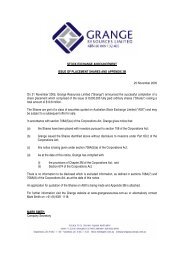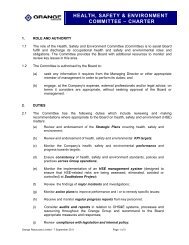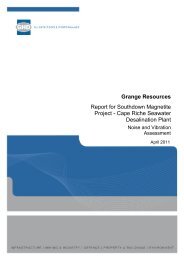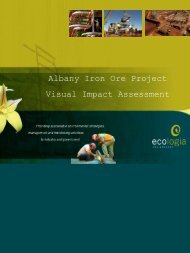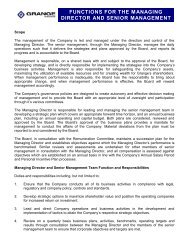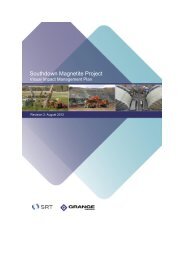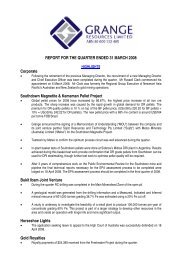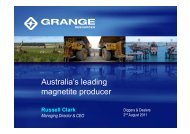2012 Annual Report (2 April 2013) - Grange Resources
2012 Annual Report (2 April 2013) - Grange Resources
2012 Annual Report (2 April 2013) - Grange Resources
You also want an ePaper? Increase the reach of your titles
YUMPU automatically turns print PDFs into web optimized ePapers that Google loves.
50<br />
PAGE<br />
<strong>2012</strong> ANNUAL REPORT<br />
Notes to the Financial Statements (cont.)<br />
NOTE 1. SUMMARY OF SIGNIFICANT<br />
ACCOUNTING POLICIES (cont.)<br />
(h)<br />
Leases<br />
Leases are classified as either operating or finance leases at the<br />
inception of the leases based on the economic substance of their<br />
agreement so as to reflect the risks and rewards incidental to<br />
ownership.<br />
Finance leases, which are those leases that transfer substantially<br />
all of the risks and rewards incidental to ownership of the leased<br />
item to the Group, are capitalised at the present value of the<br />
minimum lease payments and disclosed as property, plant and<br />
equipment. A lease liability of equal value is also recognised. Each<br />
lease payment is allocated between the liability and financing<br />
costs. The finance cost is charged to the income statement over<br />
the lease period so as to produce a constant periodic rate of<br />
interest on the remaining balance of the liability over the period.<br />
The property, plant and equipment acquired under a finance lease<br />
is depreciated over the asset’s useful life or over the shorter of<br />
the asset’s useful life and the lease term if there is no reasonable<br />
certainty that the Group will obtain ownership at the end of the<br />
lease term.<br />
Operating leases are those leases that do not transfer a significant<br />
portion of the risks and rewards of ownership to the Group as<br />
lessee. Payments made under operating leases are charged to<br />
the income statement on a straight-line basis over the period of<br />
the lease.<br />
(i) Cash and cash equivalents<br />
Cash and cash equivalents comprise cash on hand, deposits held<br />
at call with financial institutions, other short-term, highly liquid<br />
investments with original maturities of three months or less that<br />
are readily convertible to amounts of cash and which are subject<br />
to an insignificant risk of changes in value, net of outstanding<br />
bank overdrafts. Bank overdrafts are shown within borrowings in<br />
current liabilities on the balance sheet.<br />
(j) Trade and other receivables<br />
Trade receivables are recognised and carried at the original<br />
invoice amount less provision for impairment. Trade receivables<br />
are generally due for settlement within 14 days.<br />
Collectability of trade receivables are reviewed on an ongoing<br />
basis. Debts which are known to be uncollectable are written<br />
off by reducing the amount directly. An allowance accounts<br />
(provision for impairment of trade receivables) is used when there<br />
is objective evidence that the Group will not be able to collect all<br />
amounts due according to the original terms of the receivables.<br />
The amount of the impairment loss is recognised in the income<br />
statement within other expenses. When a trade receivable for<br />
which an impairment allowance had been recognised become<br />
uncollectable in a subsequent period, it is written off against the<br />
allowance account. Subsequent recoveries of amounts previously<br />
written off are credited against other expenses in the income<br />
statement.<br />
Term deposits held with financial institutions with maturities of<br />
more than three months are presented as receivables. Term<br />
deposits with a maturity date of more than 12 months after the<br />
reporting date are classified as non-current.<br />
(k) Inventories<br />
Raw materials and stores, ore stockpiles, work in progress and<br />
finished goods are stated at the lower of cost and net realisable<br />
value. Cost is determined primarily on the basis of weighted<br />
average costs and comprises of cost of direct materials and the<br />
costs of production which include:<br />
◆ ◆ labour costs, materials and contractor expenses which are<br />
directly attributable to the extraction and processing of ore;<br />
◆ ◆ depreciation of property, plant and equipment used in the<br />
extraction and processing of ore; and<br />
◆ ◆ production overheads directly attributable to the extraction<br />
and processing of ore.<br />
Stockpiles represent ore that has been extracted and is available<br />
for further processing. If there is significant uncertainty as to<br />
when the stockpiled ore will be processed it is expensed as<br />
incurred. Where the future processing of the ore can be predicted<br />
with confidence because it exceeds the mine’s cut-off grade, it<br />
is valued at the lower of cost and net realisable value. Work in<br />
progress inventory includes partly processed material. Quantities<br />
are assessed primarily through surveys and assays.<br />
Net realisable value is the estimated selling price in the ordinary<br />
course of business less the estimated costs of completion and<br />
the estimated costs necessary to make the sale.<br />
(l) Income tax<br />
The income tax expense or benefit for the period is the tax<br />
payable on the current period’s taxable income based on the<br />
applicable income tax rate for each jurisdiction adjusted by<br />
changes in deferred tax assets and liabilities attributable to<br />
temporary differences and to unused tax losses.



